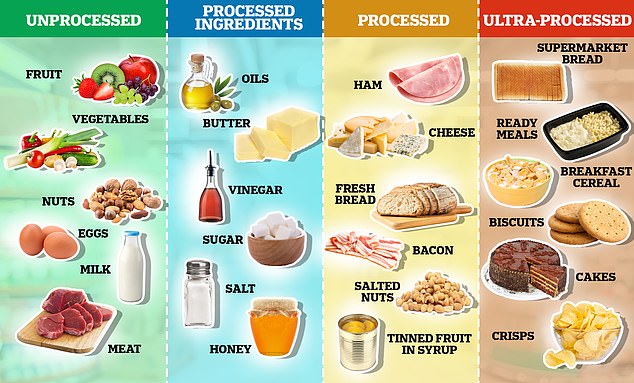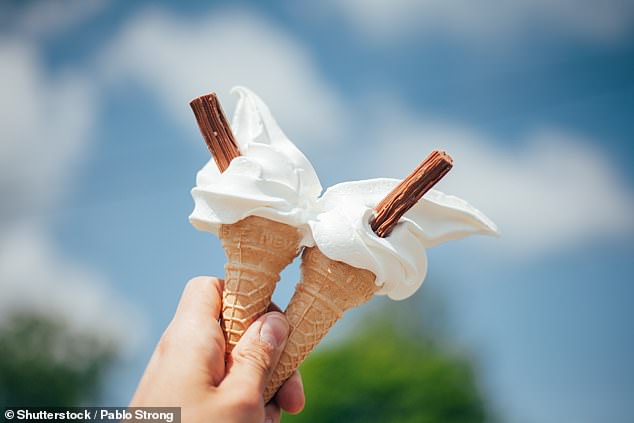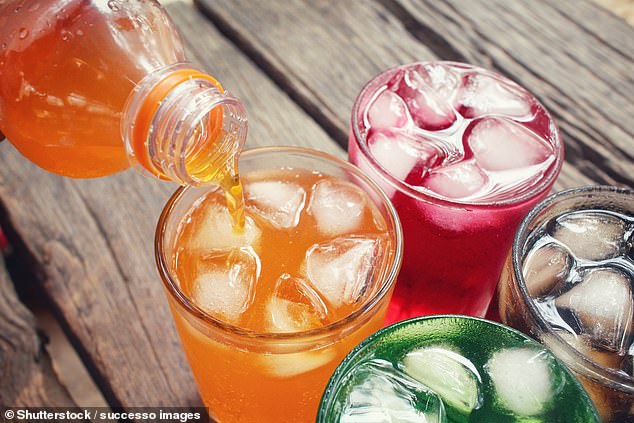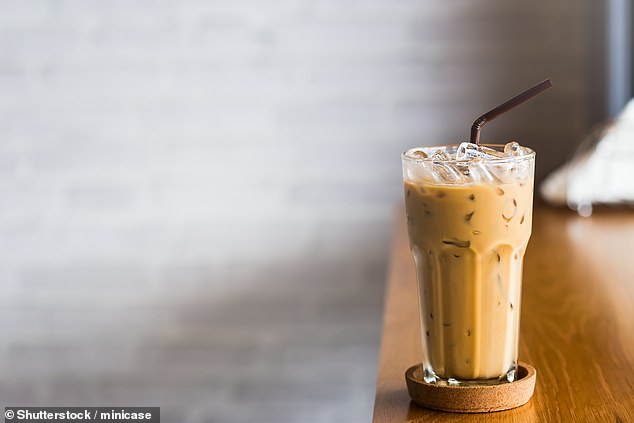Heatwave food substitutes: Top nutritionist reveals alternatives to sugary ice creams, lollies and fizzy drinks that will keep you cool and save HUNDREDS of calories
When temperatures rise, it’s only natural that you might crave a cooling ice cream, an iced coffee or a refreshing cold beer.
But these summer treats, packed with sugar and calories, won’t just keep you feeling cold—they could also make you gain weight.
A single Magnum contains about 250 calories and 12 to 21 grams of sugar, depending on the variety. A Starbucks Java Chip Frappuccino costs 395 calories and contains a whopping 40 grams of sugar. That’s more than two Snickers bars.
A pint of medium-sized Coca-Cola contains about 200 calories and a can of Coca-Cola contains 139 calories and 39 grams of sugar.
For context, the average woman is advised to eat 2,000 calories a day to maintain a healthy weight, and 2,500 is recommended for the typical man. The NHS also advises adults to eat no more than 30g of free sugars.
London-based nutritionist Beanie Robinson, founder of The Health Space, offers some healthier recipes to keep us cool this summer
But London-based nutritionist Beanie Robinson, founder of The Health Space, says there are plenty of healthier choices you can make.
Beware of UPFs hidden in ‘healthy’ candies
Ultra-processed foods (UPFs) are loaded with fat, salt and sugar and have been vilified in recent years for being unhealthy.
And many ice creams and lollies available in British supermarkets, while refreshing, can be considered a UPF:bBy definition, these are foods that have been modified in various ways to extend their shelf life.
Or they contain additives to make them more appealing to the consumer, and sometimes both.
Critics of the products say that an easy sign that a food has a UPF is if it contains ingredients you won’t find in your kitchen cupboards, such as unrecognizable dyes, sweeteners and preservatives.
Another clue is the amount of fat, salt and sugar in each package. UPFs often contain high concentrations.
Ms Robinson explained that when looking for ‘healthier’ alternatives, we want to find products that ‘do not contain added or artificial sugars and syrups’.

An easy sign that a food could be a UPF is if it contains ingredients that you wouldn’t find in your kitchen cupboard, such as unrecognisable dyes, sweeteners and preservatives. Another clue is the amount of fat, salt and sugar that is in each package, with UPFs typically containing high amounts
These may be listed on labels as sucralose, maltodextrin, dextrose, or fructose.
Other UPF ingredients commonly found in lollipops and ice creams include stabilizers and emulsifiers such as carrageenan, soy lecithin, guar gum, emulsifiers and preservatives including sodium benzoate.
“Many products claim through their branding and marketing that they are healthier, but always check the ingredients as this is often not true,” she warns.
For example, Jude’s Watermelon Rockets are labeled ‘lower sugar’ and seem like a more diet-conscious choice than the more synthetic-looking Calippo lollipops.
However, the ingredients are largely the same.
They both contain “They contain stabilisers, syrups and flavourings and are high in sugar,” said Ms Robinson.
‘Of course, there’s no problem with these foods in moderation, but if you’re looking for less processed alternatives, we can easily create refreshing summer treats and drinks with fewer additives.’

Ms Robinson claims that Rowntree watermelon lollipops, Solero and Cornetto contain multiple purees, caramelised sugar syrups, thickeners, sugars, artificial sweeteners and reconstituted milk products, all of which makes them UPFs
Changes of ice cream and lollipops
Opting for healthier summer treats doesn’t mean you have to avoid ice cream altogether.
Mrs Robinson suggests trying Yeo ice cream, which has 144 calories per 100ml serving as it has fewer ingredients.
She said: ‘Organic dairy and organic sugar are used and all artificial sweeteners, stabilisers and preservatives are avoided.
‘The vanilla and chocolate varieties taste at least as good as their sugary competitors.’
Another sweet treat that doesn’t contain UPF additives is frozen bananas.
Mrs Robinson suggests slicing bananas and rolling them in melted 70 per cent LINDT dark chocolate with sea salt. You can then freeze them to make a mini dessert.
A good alternative to regular sugary lollipops are lollipops made from real fruit, such as Lickalix. These contain 49 calories per lollipop.
Lickalix Organic Strawberry Lemonade Popsicles not only contain fewer calories, but also only 11.2 grams of sugar.
For comparison, a Calippo Orange ice cream contains 104 calories and 17 grams of sugar.
If you like a Solero, which contains 98 calories and 12 grams of sugar, you can opt for the healthier alternative with orange, carrot and ginger from Gigi.
It contains 84 calories and 12 grams of sugar, but it is real fruit.
You can also make delicious lollipops at home, says Mrs Robinson.
Simply blend a smoothie with frozen berries, organic Greek yogurt, almond milk, cinnamon, half a banana and a teaspoon of almond butter.
Mix with cacao nibs and coconut flakes before freezing.
She suggests adding fresh fruit or dark chocolate to the coconut or Greek yogurt, with a little vanilla paste or maple syrup for sweetness, to create a tasty, healthy sorbet.

A 250ml portion of Coca-Cola original contains 105 calories and 27g of sugars. A 330ml can of Fanta orange contains 63 calories and 15g of sugars.
Replacing soft drinks…
Quenching your thirst with a full-bodied Sprite, Fanta or Coke isn’t the healthiest option.
A 250ml portion of Coca-Cola original contains 105 calories and 27g of sugars. A 330ml can of Fanta orange contains 63 calories and 15g of sugars.
But if you want a “healthier” store-bought beverage, Ms. Robinson recommends opting for Something and Nothing seltzers (44 calories), Nuisance (50 calories) and Dash water, which has 0 grams of sugar and 1 calorie.
If you have more time, you can of course also make your own soft drink.
“Watermelon Sizzler is a great drink, better than the soda you buy in the store,” said Ms. Robinson.
To make it, simply add ice, watermelon, fresh mint, and lime to a blender. If you want it to be fizzy, you can add sparkling water.

Some iced coffee drinks are loaded with sugar. For example, the large Caramel Frappuccino at Starbucks has 72 grams of sugar and 470 calories. The large Iced French Vanilla at McDonald’s has 330 calories and 31 grams of added sugar.
A healthier iced coffee…
Ice cold caffeinated drinks are refreshing on a summer day.
But some iced coffee drinks contain a lot of sugar.
For example, the large Caramel Frappuccino at Starbucks contains 72 grams of sugar and 470 calories.
The large Iced French Vanilla at McDonald’s contains 330 calories and 31 grams of added sugars.
Ms Robinson suggests making a ‘healthy iced mocha’ which she claims is lower in sugar. It contains coffee, almond milk, cocoa powder and a teaspoon of honey, all mixed in the blender with ice.
For a refreshing iced tea, she recommends brewing a berry herbal tea, blending it with ice and serving with a slice of lemon or lime.
